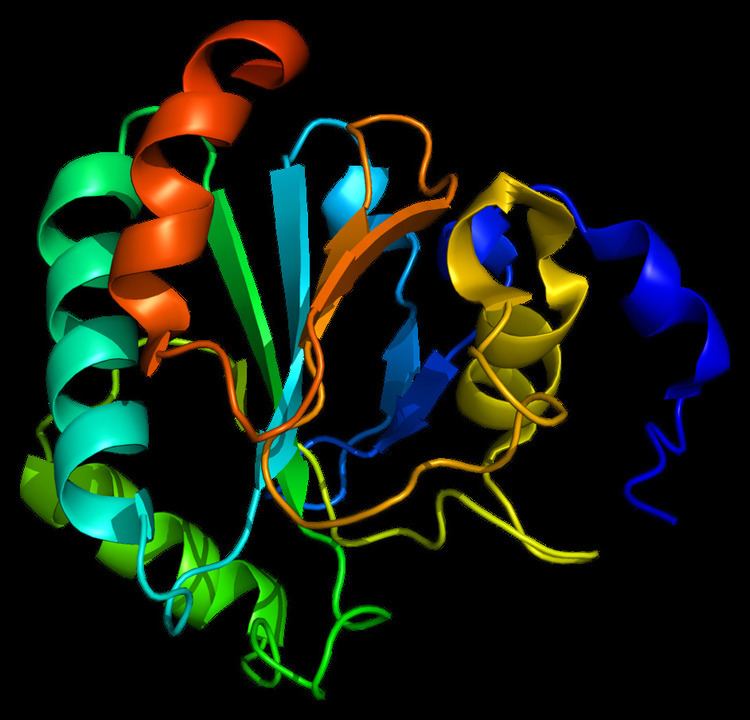Species Human Entrez 2879 | Human Mouse Ensembl ENSG00000167468 | |
 | ||
Aliases GPX4, GPx-4, GSHPx-4, MCSP, PHGPx, snGPx, snPHGPx, SMDS, glutathione peroxidase 4 External IDs MGI: 104767 HomoloGene: 134384 GeneCards: GPX4 | ||
Glutathione peroxidase 4, also known as GPX4, is an enzyme that in humans is encoded by the GPX4 gene. GPX4 is a phospholipid hydroperoxidase that protects cells against membrane lipid peroxidation.
Contents
Function
The antioxidant enzyme glutathione peroxidase 4 (GPx4) belongs to the family of glutathione peroxidases, which consists of 8 known mammalian isoenzymes (GPx1-8). Gpx4 catalyzes the reduction of hydrogen peroxide, organic hydroperoxides, and lipid peroxides at the expense of reduced glutathione and functions in the protection of cells against oxidative stress. The oxidized form of glutathione (glutathione disulfide), which is generated during the reduction of hydroperoxides by GPx4, is recycled by glutathione reductase and NADPH/H+. GPx4 differs from the other GPx family members in terms of its monomeric structure, a less restricted dependence on glutathione as reducing substrate, and the ability to reduce lipid-hydroperoxides inside biological membranes.
Inactivation of GPX4 leads to an accumulation of lipid peroxides, resulting in ferroptotic cell death. Mutations in GPX4 cause spondylometaphyseal dysplasia .
Structure
Mammalian GPx1, GPx2, GPx3, and GPx4 (this protein) have been shown to be selenium-containing enzymes, whereas GPx6 is a selenoprotein in humans with cysteine-containing homologues in rodents. In selenoproteins, the 21st amino acid selenocysteine is inserted in the nascent polypeptide chain during the process of translational recoding of the UGA stop codon. GPx4 shares the amino acid motif of selenocysteine, glutamine, and tryptophane (catalytic triad) with other glutathione peroxidases.
Reaction mechanism
GPx4 catalyzes the following reaction:
This reaction occurs at the selenocysteine within the catalytic center of GPx4. During the catalytic cycle of GPx4, the active selenol (-SeH) is oxidized by peroxides to selenenic acid (-SeOH), which is then reduced with glutathione (GSH) to an intermediate selenodisulfide (-Se-SG). GPx4 is eventually reactivated by a second glutathione molecule, releasing glutathione disulfide (GS-SG).
Subcellular distribution of isoforms
In mouse and rat, three distinct GPx4 isoforms with different subcellular localization are produced through alternative splicing and transcription initiation; cytosolic GPx4, mitochondrial GPx4 (mGPx4), and nuclear GPx4 (nGPx4). Cytosolic GPx4 has been identified as the only GPx4 isoform being essential for embryonic development and cell survival. The GPx4 isoforms mGPx4 and nGPx4 have been implicated in spermatogenesis and male fertility. In humans, experimental evidence for alternative splicing exists; alternative transcription initiation and the cleavage sites of the mitochondrial and nuclear transit peptides need to be experimentally verified.
Animal models
Knockout mice of GPX4 die at embryonic day 8 and conditional inducible deletion in adult mice (neurons) results in degeneration and death in less than a month. Targeted disruption of the mitochondrial GPx4 isoform (mGPx4) caused infertility in male mice and disruption of the nuclear GPx4 isoform (nGPx4) reduced the structural stability of sperm chromatin, yet both knockout mouse models (for mGPx4 and nGPx4) were fully viable. Surprisingly, knockout of GPX4 heterozygously in mice (GPX4+/−) increases their median life span. Knockout studies with GPx1, GPx2, or GPx3 deficient mice showed that cytosolic GPx4 is so far the only glutathione peroxidase that is indispensable for embryonic development and cell survival. As mechanisms to dispose of both hydrogen peroxide and lipid hydroperoxides are essential to life, this indicates that in contrast to the multiple metabolic pathways that can be utilised to dispose of hydrogen peroxide, pathways for the disposal of lipid hydroperoxides are limited.
While mammals have only one copy of the GPX4 gene, fish have two copies, GPX4a and GPX4b. The GPX4's appear to play a greater role in the fish GPX system than in mammals. For example, in fish GPX4 activity contributes to a greater extent to total GPX activity, GPX4a is the most highly expressed selenoprotein mRNA (in contrast to mammals where it is GPX1 mRNA) and GPX4a appears to be highly inducible to changes within the cellular environment, such as changes in methylmercury and selenium status.
